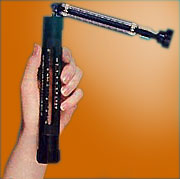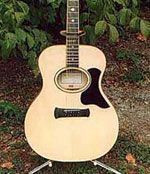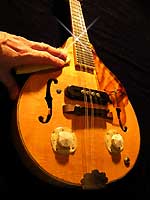

Ironically, hand-made high-performance guitars are more susceptible to damage than cheaper instruments, due to more delicate construction, thinner tops, and lighter bracing. Cheap, plywood guitars may sound really horrible, but they require much less care than a wonderful-sounding guitar made from solid woods and built to very close tolerances.
 High humidity can cause the soundbox to arch a little, as in the diagram at right. Low humidity will have the opposite effect. If the bridge rises high enough, the action becomes too high and the guitar becomes more difficult to play. If the bridge drops far enough, the action becomes too low and the strings may buzz against the frets.
High humidity can cause the soundbox to arch a little, as in the diagram at right. Low humidity will have the opposite effect. If the bridge rises high enough, the action becomes too high and the guitar becomes more difficult to play. If the bridge drops far enough, the action becomes too low and the strings may buzz against the frets.
This scenario is complicated by a couple of other factors.
The soundboard of a guitar underneath the bridge will normally arch up a little between the bridge and the soundhole because of string tension. If the bracing underneath the soundboard is too weak the opposite effect can occur—a dishing in front of the bridge. A bridge plate that has separated from the soundboard can cause dishing. The bridge itself is attempting to rotate forward under string pressure. You can spot this because the soundboard rises up behind the bridge and dishes down in front of it (near the soundhole). This can cause the action to become too low and the guitar strings may start buzzing on the frets.
The soundboard may also arch outward or dish inward too much if the bracing is weak or if braces have come loose. This can be caused by using strings that are too heavy a gauge for the guitar, or from tuning the guitar too high in pitch. This problem is usually confined to acoustic steel string guitars, which are subject to much higher tension that nylon string or electric guitars. Never raise the pitch of your guitar higher than normal. Use a capo instead.
As long as the action of the guitar is not compromised and as long as the braces do not come loose, small changes in soundboard height can be expected and are usually not a problem. A certain amount of arching in either direction is normal.
Ideally, an instrument that will live in a home with central heating should be built in an environment where the relative humidity is no higher than 45%. Most professional luthiers keep their workshop between 25% and 45% during gluing procedures. At Schneider Guitars we have one room for gluing and another room, even drier, for storing tone wood.
The problem with guitars built in more humid equatorial regions is that they will nearly always crack when sent to the United States and put into a home with central heating. A guitar built in the United States during wet summer months will almost certainly crack the first winter. One way that manufacturers prevent this from happening is by building guitars with plywood instead of solid woods, since laminated woods are much less likely to crack when dried out. A responsible workshop in any country will build their guitars in a humidity-controlled environment.
If the humidity in your home drops much below 25%, you can expect some cracking or action problems. Don't trust your inexpensive hygrometer to tell you when the humidity is too low. You will know it because it will also cause breathing problems, allergies, and maybe a bloody nose. It is unusual for any home to get this dry unless it is very well sealed and very warm on a cold winter's day.
The reverse is rarely a problem. If a guitar is built in an extremely dry environment, say 25% relative humidity, and you have a really wet summer when the humidity hovers around 100%, you will probably not have any cracking. The action may be higher and the instrument may sound like a wet dishrag, but it shouldn’t crack.
Most acoustical instruments sound better when they are in the dry to medium range, so you could consider storing the guitar in an air-conditioned room to keep it from loosing the crisp, clear sound that it has when it is drier outside.
When the heat comes on in your home, you should be aware of how dry it can get. If the humidity drops below 35%, I would definitely recommend a humidity wick in the guitar to keep it from getting too dry. There are also many types of room humidifiers and furnace humidifiers available to put moisture back into the air in your home. Please see the note "Humidifier Basics" below.
If you have a buzzing sound in the guitar, there are several things to check for:
Anyone with a serious collection of wooden musical instruments should treat them the same respect as any museum and invest in a reliable hygrometer. The dial-type analog hygrometers sold in department stores are completely unreliable. They are sold for decorative purposes only and can be off by as much as 40%! The next time you see a display of dial-type hygrometers, compare them. They will all give vastly different readings! When you buy an accurate analog hygrometer, it will come with a certificate of accuracy. A certified hygrometer is typically certified to be accurate within ± 3% RH. Each instrument has been tested at three different positions of the dial at temperatures ranging from 32 to 230 degrees F. The calibration and certification are done under ISO-9001 control. Cerified hygrometers are available from Elderly Instruments. (We have no affilitation with this company).
Analog Instruments that are good to plus or minus 3 percent (between 10 and 95 percent RH) and plus or minus 1 degree F (between 0 and 100 degrees) should cost around $150.00-$300.00. Digital instruments can cost a bit less, but still need to be tested. We know from experience that some of the more expensive ones don't deliver the accuracy promised. If you haven’t bought your hygrometer from a reputable science firm with a certificate of accuracy, you need to replace it.
 If you have a collection of valuable acoustic instruments, you should also have a swing psychrometer. This relatively inexpensive little gadget will give you a very precise reading of the relative humidity and will also allow you to check the accuracy of your dial hygrometers. It consists of two thermometers mounted side by side. One of them will have a bit of wicking material wrapped around the base. When you wet this material you have a wet-bulb and a dry-bulb thermometer next to each other. You swing them around over your head for a few minutes, then compare the reading of the two thermometers. The difference is plotted on a chart to show the relative humidity of the room. We check our hygrometers once a year with a swing psychrometer to make sure they are behaving.
If you have a collection of valuable acoustic instruments, you should also have a swing psychrometer. This relatively inexpensive little gadget will give you a very precise reading of the relative humidity and will also allow you to check the accuracy of your dial hygrometers. It consists of two thermometers mounted side by side. One of them will have a bit of wicking material wrapped around the base. When you wet this material you have a wet-bulb and a dry-bulb thermometer next to each other. You swing them around over your head for a few minutes, then compare the reading of the two thermometers. The difference is plotted on a chart to show the relative humidity of the room. We check our hygrometers once a year with a swing psychrometer to make sure they are behaving.
If you don’t like the dry, brittle sound of your guitar when the humidity is too low, get a guitar humidifier. One type is a rubber tube with a sponge inside that you hang in the guitar soundhole. Keep it damp but never let it drip into the guitar. Another type is the clay humidifier. These retain water in a small clay-filled container and they maintain a more constant humidity than the sponge wick. Also, they don’t dry out as quickly. Either one works well in extremely dry conditions.

Some people seem to think that you need to use a dampit or other humdifier in the summer. This is a really bad idea.
I strongly advise everyone to get a hard shell case for their guitar. Soft gig bags and pasteboard cases with fold-over latches offer a false sense of security and can lead to a damaged guitar if you bang them into something. Get a hard shell case that your guitar fits into snugly. There are various levels of quality in hard shell cases. The cheapest hardshell cases are made from 3 ply plywood with a flat top & bottom. They will protect your guitar from hard knocks, but you can’t set anything heavy on top of them. If someone fell on your guitar case, the guitar could still be cracked. Better cases have arched tops and backs, making them resistant to heavy objects. Because they are not flat, people resist the temptation to set something, like a suitcase or amplifier, on top of them. Molded plastic cases are lighter in weight but are not quite as rugged. If you really need the ultimate protection for your guitar and don’t mind paying for it, get a flight case.
I never lay my guitar on the floor or lean it against a chair or the wall. Whenever I am playing, my guitar case is next to me. When I set my guitar down, it goes in the case, the top is closed, and I latch at least one latch (in case someone tries to pick it up or move it).
 I use a guitar stand with non-slip rubber or felt padding to hold the guitar during gigs. A rubber band secures the neck to the stand to keep it from getting knocked off. It also discourages people from grabbing it off the stand. The rubber band attachments are available where you bought the stand.
I use a guitar stand with non-slip rubber or felt padding to hold the guitar during gigs. A rubber band secures the neck to the stand to keep it from getting knocked off. It also discourages people from grabbing it off the stand. The rubber band attachments are available where you bought the stand.
If you guitar case comes with a little dial hygrometer built into it, it’s probably useless. There is no way a manufacturer is going to put a $200.00 certified hygrometer into a $150.00 guitar case.
Things that might damage or melt the finish on your guitar:
 Use a clean lint-free cotton cloth to wipe your guitar. If there is an area that will not come clean, moisten the cloth a little. Never use paper towels, which will scratch the finish. Baby diapers are a great source of inexpensive cloth towels. Make sure they are 100% cotton. Commercial guitar polish can also be used. If you have an older guitar with a varnish finish, try to find a polish with lemon oil in it. If your guitar has cracks in the finish don’t use a penetrating oil at all. The polish could get in the cracks and stain the wood.
Use a clean lint-free cotton cloth to wipe your guitar. If there is an area that will not come clean, moisten the cloth a little. Never use paper towels, which will scratch the finish. Baby diapers are a great source of inexpensive cloth towels. Make sure they are 100% cotton. Commercial guitar polish can also be used. If you have an older guitar with a varnish finish, try to find a polish with lemon oil in it. If your guitar has cracks in the finish don’t use a penetrating oil at all. The polish could get in the cracks and stain the wood.
A guitar with a flat (non-glossy) finish will become glossy over time if repeatedly polished. Your shirt sleeve or your pants will make it glossy from constant rubbing over time. These instruments are finished with the same material as shiny guitars, but it is treated differently to make it flat instead of glossy. This saves the manufacturer some time and money since he doesn’t have to polish out the guitar or be as fussy when he sprays on the finish. Martin recommends not polishing their flat or satin finish guitars with their polish. It won’t harm the finish but it could make it unevenly glossy. Some performers prefer a flat finish because stage lights won't reflect off the guitar on stage.
Avoid rapid temperature changes (more than 20 degrees F per hour), and exposure to temperatures less than 32 F or more than 105 F. If you bring your guitar in from the cold in the winter, try to let it warm up in the case for a while before you take it out. If a guitar has been in the bitter cold and is allowed to warm up quickly, the wood will expand more quickly than the finish, causing checking or crazing of the finish. The braces may also expand more slowly than the top and back, causing them to loosen. Crazing is a tiny pattern of cracks that looks like a dried riverbed. It is commonly seen on old instruments where the varnish has hardened over many years.
If store your guitar for a long time without playing (more than a few months), lower the string tension, but don’t loosen the strings completely. Leave a little tension on the strings. Clean and polish the guitar. A sweaty fingerprint can etch itself into the finish if left on the guitar.
Direct sunlight can soften the glues in your guitar allowing the string tension to pull off the bridge or lift the top.
Never try to adjust the action of a guitar by adjusting the truss rod yourself. Leave this to a guitar repair person. If you overtighten the truss rod, it could snap. This is a very expensive repair. If your guitar does not have a truss rod (most classical or nylon string guitars to not) a qualified technician can adjust the neck by heating and bending it with a special neck-bending iron.